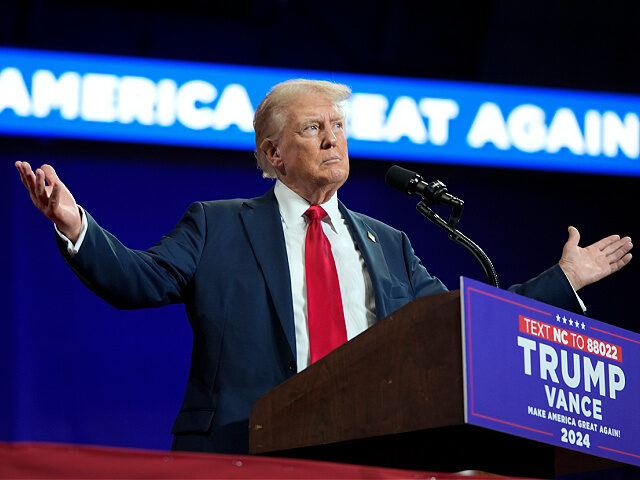As Vice President Kamala Harris and former President Donald J. Trump gear up for the final 30 days in the race for the White House, they find themselves in a tightly contested battle stretching from the Rust Belt to the Sun Belt.
Polling averages indicate that all seven key battleground states are nearly evenly matched. Many Democrats believe their primary strength lies in the robust ground game their party has built over the past year. Meanwhile, Trump’s campaign is optimistic that recent developments—such as the rising tensions in the Middle East and devastating hurricanes that have resulted in over 200 fatalities in the Southeast—will give them an advantage as the election approaches.
This scenario mirrors the closing days of the 2016 election, where Hillary Clinton’s campaign highlighted its large, data-driven ground operation, while Trump focused on a national message centered around anti-immigrant sentiments and economic improvement, despite having a relatively small team and minimal field presence in crucial states. Ultimately, Trump triumphed, aided by the FBI’s decision to revisit an investigation into the Democratic nominee’s emails.
This time, however, Democrats are cautious. Despite Trump’s party facing losses in major elections since then, many in the Democratic camp feel that this year could still slip away from them.
“Anybody would be a fool to write Trump off,” said Julián Castro, the former San Antonio mayor who ran for president in 2020. “I think she’s going to win, but am I absolutely sure she’s going to win? No. The 2016 experience taught all of us that you can’t count this guy out.”
Veterans of presidential campaigns note that this year’s election is unique in how little major political events seem to affect the candidates’ standings. Despite two assassination attempts on Trump, a presidential and vice-presidential debate, and the party conventions providing temporary boosts for both him and Harris, there have been no lasting changes in public opinion.
Consequently, top officials from both campaigns describe the race as a grind, where shifts measured in just a few thousand votes could determine the election’s outcome.
Ralph Reed, a socially conservative activist in Georgia assisting with voter turnout for the Trump campaign, remarked that he cannot recall a presidential race since 2000 where so many states were effectively tied this late in the game.
“In the battleground states, it is like trench warfare during the First World War,” he said. “Everybody is dug in. Everybody is throwing artillery and machine gun fire, and it’s just a no man’s land.”
The closeness of the race has led to a surge in spending, particularly in key battlegrounds like Georgia, Arizona, Nevada, North Carolina, Wisconsin, Michigan, and Pennsylvania.
Officials from both campaigns declined to prioritize the states, asserting that all of them remain highly competitive.
“There is not, in my mind, a blue wall path or a Southern path or a Western path,” said Dan Kanninen, the Harris campaign’s battleground states director. “We’re competing to win close races across all seven, because at the end of the day, I believe any one of them could be the tipping point state.”
Since September 1, over $675 million has been allocated for television and digital advertising, according to AdImpact, a media tracking company. The Harris campaign has consistently outspent the Trump campaign on ads in all seven battleground states. Additionally, Democratic third-party organizations have outpaced their Republican counterparts in ad spending across these states.
However, Republicans are flooding key states with direct mail, resulting in Democrats reporting an overwhelming influx of glossy materials that criticize Harris and portray Trump as a defender of Social Security benefits.
Mintt, a mail tracking firm, discovered that in September, 81 percent of all direct mail focused on promoting Trump or attacking Harris. The disparity was even greater in August, with Republican groups responsible for 96 percent of all presidential race-related direct mail.
“Advertising and ground game operations are inundating all these states to find the thousands of voters who will determine the winners,” said Nick Everhart, a national Republican consultant and ad buyer. “Every week, every day, every minute, every second matters when a campaign is this close without a clear inflection point on the horizon.”
Republicans acknowledge they are being outspent on television and out-organized in key states, yet they believe Trump’s strengths in the economy and immigration could help him overcome these challenges.
Surveys suggest that Republicans still have an edge on economic issues, even as inflation slows, gas prices decrease, and the Federal Reserve cuts interest rates for the first time in four years. Public sentiment on immigration has also shifted rightward under the Biden administration, with more Americans favoring tougher enforcement against illegal immigration.
Former Wisconsin Governor Scott Walker, a Republican, estimated that there were ten ads for Harris for every one for Trump during this week’s Milwaukee Brewers playoff games. He also conceded that Wisconsin Democrats have built a larger and more effective organization than the Republicans.
“You definitely see the financial advantage for them,” Mr. Walker said. “The thing that keeps it close, just as it is elsewhere in the country, is that the issue matrix is on the side of Republicans.”
All this spending aims to reach a small fraction of the millions expected to vote. According to Jim Messina, a Democratic strategist supporting Harris through allied groups, only 4 percent of voters in battleground states are uncertain about how or whether they will cast their ballots.
Interestingly, the primary targets for both campaigns are not those undecided about which candidate to choose, but rather those who are unsure if they will vote at all.
“Our No. 1 priority should be turning out folks that sometimes are deciding whether to show up or not on Election Day, and that’s going to be a really deciding element to the election,” said Representative Alexandria Ocasio-Cortez, Democrat of New York, after a campaign stop in Wisconsin last week. “It’s about the choice between staying home or participating in our process.”
The Harris campaign believes they have established an organization capable of reaching those voters, with hundreds of organizers and numerous offices across all seven swing states. Campaign aides point out key differences between their operation and Clinton’s campaign; while Clinton focused primarily on mobilizing the Democratic base, they are actively working to reduce Trump’s margins in rural and conservative areas.
Their field efforts aim to engage both dedicated Democrats and moderate Republicans who previously supported Trump but now disapprove of his indictments, impeachments, and overall behavior since leaving office.
In contrast, Trump’s aides view recent events as bolstering their main campaign message that Harris is unprepared, weak, and unable to restore the calm that the Biden administration promised four years ago.
They believe they are competing in a country that has become more conservative over the past four years, citing surveys that show an increase in voters identifying as Republican and a growing alignment with their issues.
“New, not-baked-in information can certainly have an impact on moving voters to President Trump or further galvanizing and motivating his supporters,” said James Blair, the Trump campaign’s political director, of the escalation of hostilities abroad and the devastating storms at home. “Those two specific pieces of new information certainly bolster the case we’ve been prosecuting.”
They have directed their ground game, much of which is managed by third-party organizations, primarily towards energizing their lowest-propensity supporters, particularly focusing on younger Black men and young men in general.
Despite this extensive field operation, some Democrats express concerns that the Harris campaign isn’t effectively reaching these voters and other smaller segments of their base.
Representative Debbie Dingell, a Democrat from Michigan who previously warned her party about losing her state in 2016, noted that Michigan remains a tossup due to factors like the conflict in Gaza and a lack of enthusiasm among the party’s core supporters.
“I cannot describe to you the anger in all of our communities,” she said. “It’s really bad. The Jewish and the Arab American communities are concerned, and many are not there. African American young men express their frustration at being taken for granted. And it’s not clear that young people will turn out.”
Campaigning in Flint, Mich., on Friday, Ms. Harris noted as much.
“This is going to be a very tight race until the very end,” she said. “We are the underdog.”











